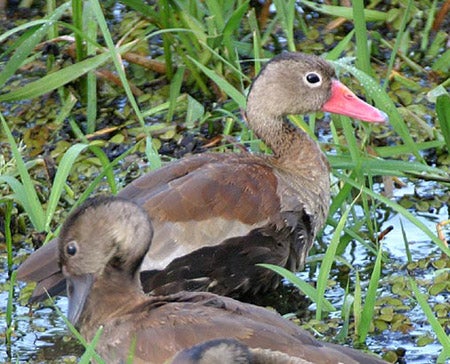SCIENTIFIC NAME:
Dendrocygna autumnalis
OTHER NAMES:
Black-bellied tree duck, red-billed whistling duck and cornfield duck. In Mexico they are locally referred to as pichichi or pato maizal (cornfield duck).
STATUS:
Local breeder. Currently rare in spring, summer, and fall in Gulf Coast region, and occasional in late spring and summer in southeast Alabama; occasional in other regions. Expanding breeding range into Alabama. MODERATE CONSERVATION CONCERN.
DESCRIPTION:
Black-bellied whistling ducks, as other whistling ducks, are more closely related to geese and swans than to ducks. They are medium sized averaging 18-21 inches in length. Both sexes are similar in size and color. In general, they have long legs and necks. When standing they are the most erect of all ducks with their posture giving them a heron-like appearance. As their name implies these birds have a black belly. The backs of their necks, lower neck, chest and back are chestnut colored. They have a chestnut cap on the top of the head with a bright red-orange bill, gray face and upper neck and a white eye ring. Their long pink legs are readily observed when perched in trees. Immature birds are similar to the adults, but duller and more grayish-brown, with gray bills and feet, and a mostly gray belly with some black spots.
In flight black-bellied whistling ducks are often described as having a “droopy” look with their most obvious features being large white wing strips on the upper, front portion of the wing, with a black band along the back margin, to and around the tip, as well as the red-orange bill and pink legs. These markings readily differentiate it from all other whistling ducks when in flight.
DISTRIBUTION:
Black-bellied whistling ducks breed in southeast Arizona, coastal Louisiana and Texas through coastal Mexico and Central America to northern Argentina. A resident breeding population also occurs in Florida. This species is occasionally observed in eastern Texas, southern Louisiana, Mississippi, Alabama Georgia and South Carolina. Black-bellied whistling ducks winter from southern Texas southwards. Northern populations may be somewhat migratory moving southwards, but most populations are resident within their range.
HABITAT:
Black-bellied whistling ducks prefer shallow freshwater ponds, lakes and marshes lined with or near trees; often near agricultural lands. They need aquatic habitats with dense vegetation for feeding as well trees nearby for nesting. Black-bellied whistling ducks can be found from sea level to 4900 feet of elevation.
FEEDING HABITS:
Feeding often occurs at night, but can occur at any hour. Black-bellied whistling ducks eat a wide variety of plant materials, but will also consume insects and aquatic invertebrates when available. The often feed on submerged vegetation by wading in flooded fields or and other shallow water areas. In Mexico they are often observed feeding on waste grain from recently harvested fields.
LIFE HISTORY AND ECOLOGY:
Black-bellied whistling ducks are highly gregarious (social) outside of the breeding season and are often seen flying in large noisy flocks repeatedly whistling pe-che-che, which provides them with one of their local names. This species was formerly known as the black-bellied tree duck; as the name suggests, they are fond of perching on trees and shrubs.
Black-bellied whistling ducks breed during their first year of life. Pairing seems to occur in winter, and bonded pairs often stay together for many years, a trait more often associated with geese and swans. These ducks typically nest in tree cavities, but will nest in artificial nest boxes or on the ground when cavities are absent. Eggs are laid directly in the bottom of the cavities often without any form of nesting material and always without down feathers.
Most ground nests are placed in grassy areas or under brush or cacti near water. Ground nests are typically composed of dead grasses woven into shallow bowls. Occasionally ground nests will be in simple shallow depressions in the ground without nest materials of any kind.
Black-bellied whistling ducks nest in loose colonies. Most nests are initiated between mid-May and mid-June. Eggs are white and laid at a rate of one per day. Normal clutches ranging from 9 to 18 eggs with an average of 13.4 eggs per clutch. Dump nests, nests in which eggs are laid by more than one hen occasionally, occur. Dump nests have been found with 40 to over 100 eggs in a single nest.
Incubation is shared by both sexes and normally ranges from 25-30 days. If one of the adults is lost during incubation the other typically abandons the nest. Some black-bellied whistling ducks will renest if their first nests are destroyed. Most nest failures are caused by desertion as a result of egg predation by raccoons or rat snakes. During the pre-incubation period nests may be taken over by golden-fronted woodpeckers.
Once the ducklings have hatched they will remain in their nests from 18 to 24 hours to allow their down to dry. Ducklings in nest cavities or nest boxes will then jump from the cavity entrance to the ground or the water. Both parents escort their broods and will remain with the young for at least six months. Young birds are able to fly at approximately eight weeks of age and become virtually indistinguishable from adults at from 16-20 weeks of age.
REFERENCES:
Bellrose, Frank C. 1976. Ducks, Geese and Swans of North America. Stackpole Books, Harrisburg, PA 543 pp.
Black-bellied Whistling Duck. http://en.wikipedia.org/wiki/Black-bellied_Whistling_Duck.
Cornell Lab of Ornithology. All About Birds (On line). Black-bellied Whistling Duck. https://www.allaboutbirds.org/guide/Black-bellied_Whistling-Duck
Author:
Ron Eakes, Wildlife Biologist, Alabama Division of Wildlife and Freshwater Fisheries







